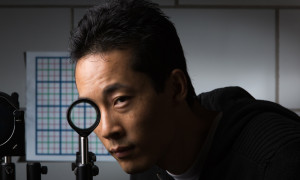In the scientific race to build fantastical devices such as invisibility cloaks, University of Arizona engineering professor Hao Xin is at the forefront.
His new discovery uses metamaterials – artificial materials engineered to bend electromagnetic, acoustic and other types of waves in ways not possible in nature – to take us one step closer to building microscopes with superlenses that see molecular-level details, therefore bringing us closer to the reality of building shields that could conceal military airplanes and people.
By using a 3-D printer to make metamaterials, Xin is able to configure objects in precise geometrical patterns to bend waves of energy in unnatural ways. Doing this allows researchers to tap into a property call negative refraction, meaning they can bend waves backwards.
In the future, someone wearing a cloak that has been manufactured with these artificially designed refraction properties would appear invisible.



